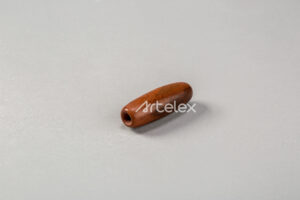This tubular jade bead is meticulously crafted with biconical piercing, exhibiting symmetrical precision in its form.
Originally a vibrant green, the jade has undergone natural aging, resulting in a rich brown hue.
The cylindrical body, slightly bulging at the center, was drilled using trumpet-shaped boring techniques and then polished to a smooth, lustrous finish across its entire surface.
Notably, the interior of the holes retains subtle traces of ancient drilling methods, offering a glimpse into its craftsmanship.
One end of the bead is notably flush, embodying the distinctive stylistic characteristics of the Hongshan Culture.
It is believed that this bead, likely used as part of a necklace, represents an evolution from earlier jade forms, such as those excavated at the Xinglongwa site in Chahai, Liaoning province.
Comparable tubular jade beads have also been uncovered at Neolithic sites like Gangseo-gu in Busan, Republic of Korea, and in tombs of the Silla Dynasty, reflecting their widespread cultural significance across different regions and eras.

